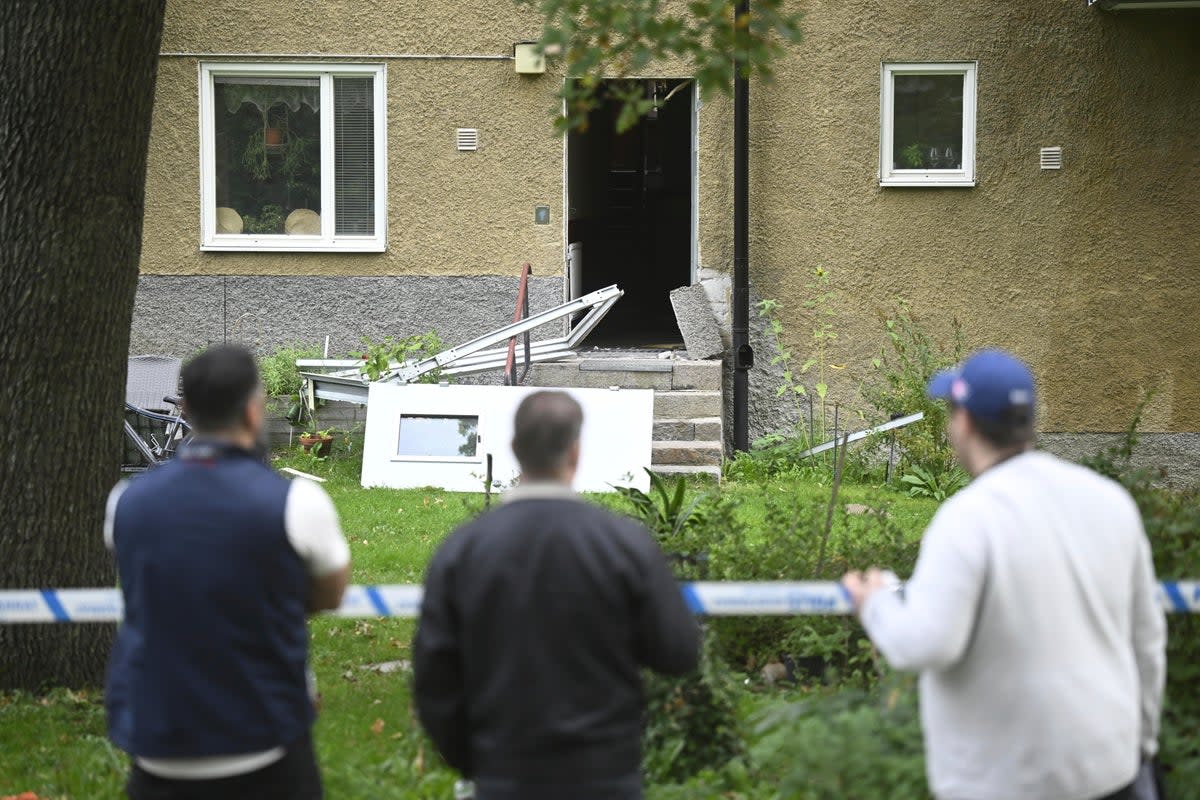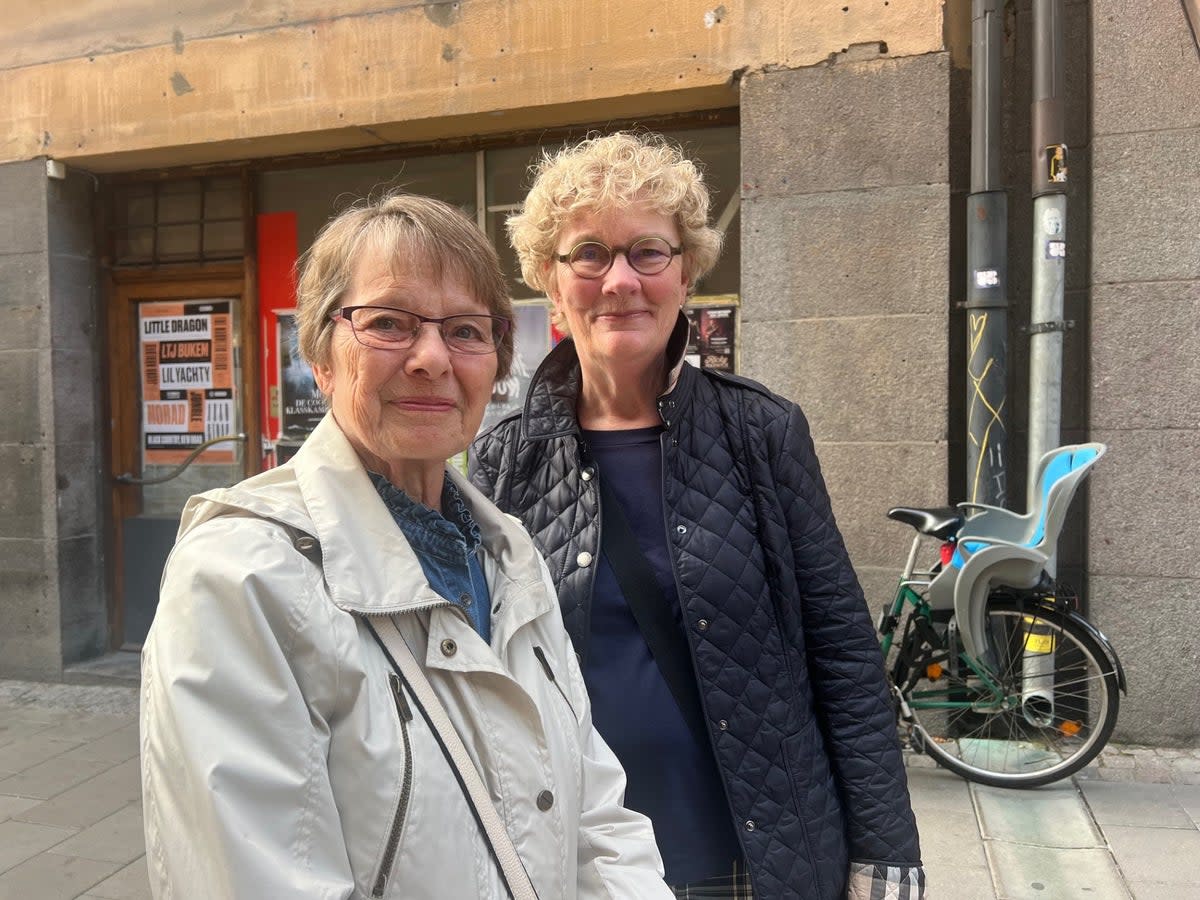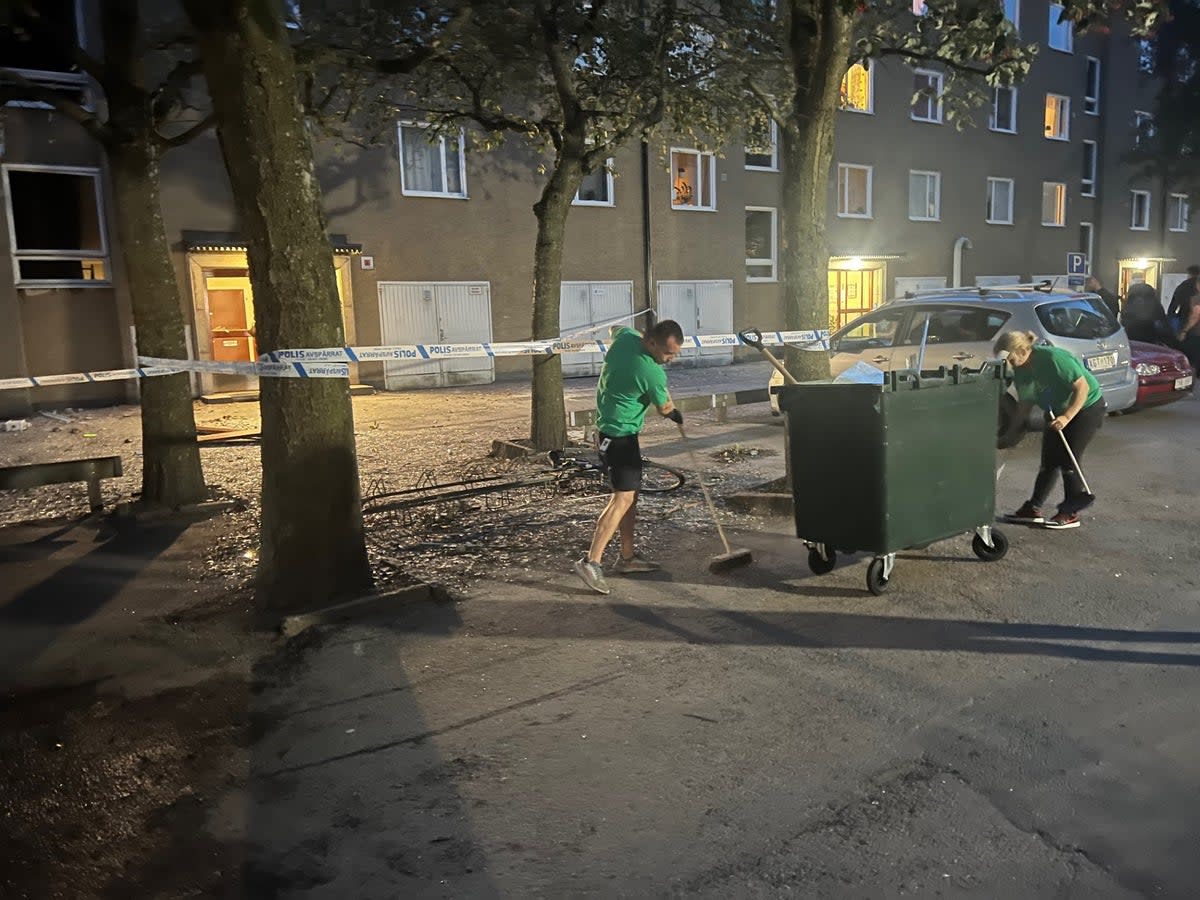Child soldiers, executions, bombs: Deadly gang violence grips Sweden

Linda, a Swede in her forties, is standing in the doorway with her children. She looks visibly upset and tired.
“I didn’t sleep much last night, I can’t take it anymore,” she tells The Independent. “The murders, the bombs, the constant police presence on the ground and police helicopters in the air. Me and my children need to get out of here. We need to move.”
Linda lives in a block of flats in Hasselby, a suburb west of Stockholm, where a bomb exploded on September 25.
Now, the day after, there is debris and broken glass everywhere. The bombed-out apartment next door is cordoned off. Police are still searching the premises.
“I was in my home on Monday night,” says Linda. “Luckily, the children were not home yet. I heard a massive blast and then loud screaming. I ran into the street and could hear the moans of a man inside the flat that had been hit. Police arrived and took him and two other injured away.”
The bloody gang war in Sweden has further intensified this week, with 11 killed this month alone. On Wednesday evening, a 20-year-old woman died in Uppsala, north of Stockholm, after an explosion ripped through the house she was staying in. She was not connected to the feud. Two young men also died from their wounds after being shot south of the capital.
‘It’s like a war zone’
Like several others in Hasselby, Linda doesn’t want her family name published in the newspaper. There is a fear of reprisals from the violent gangs that terrorise many Swedish cities.
In 2022, there were 391 shootings in Sweden, 62 of which were fatal, making Sweden the gun murder capital of Europe.
“I am not so worried about my girls, but I do worry about the boys. My oldest is thirteen. I need to protect him. He can’t get involved in this terrible gang war,” says Linda.
Hasselby Strand mainly consists of modern flats, highrises, and other three-storey buildings like Linda’s. Children are playing football on the floodlit pitch a few hundred metres away. A father and his son are out walking their dog.
“Hasselby was a wonderful place to live, only 30 minutes from the centre of Stockholm. Here we have the sea, it is green and leafy, and we used to love it here. I have lived in Hasselby Strand since 1995, but then the foreigners started coming,” Erik Petterson tells The Independent.
“Don’t get me wrong, I am not a racist, but there is no way around it. The trouble started when more and more migrants came to Hasselby. Now it is like a war zone. It is like a bad dream, a nightmare.”
The story repeats itself in most Swedish cities. Almost every day, there are new stories from the brutal gang war. The uneasiness in talking about migrants and foreigners is notable when speaking to locals in Stockholm.
Sweden was, for many years, one of the most welcoming countries in Europe in opening its borders to migrants. The number of foreigners has increased dramatically. In 2012, 1.47 million inhabitants had been born outside Sweden. This number increased to 2.15 million by 2022. Foreign-born citizens made up around 20 per cent of the population of Sweden in 2022, according to Statista, quoting figures from Sweden’s statistics office.
“Now, everything has changed. Sweden has changed. I don’t recognise the Sweden I knew anymore. And the violence seems to be spreading everywhere. It feels like it is getting closer and closer,” says Katarina Lindgren, a woman walking with her friend in central Stockholm.

Blaming migration ‘an oversimplification’
Politically, Sweden has taken a sharp turn to the right. In the 2022 general election, the nationalist right-wing populist party, the Sweden Democrats (SD), got 20 per cent of the vote, becoming Sweden’s second-biggest party.
SD is backing the centre-right coalition government through a supply and confidence deal. SD is strictly anti-immigration, and Sweden is tightening its migration policies dramatically in line with the hardline stance taken in neighbouring Denmark with some of Europe’s most restrictive migration laws.
However, according to Manne Gerell, a leading Swedish criminologist from Malmo University, the clampdown on migration to solve the gang wars is a politically motivated oversimplification.
“There is no doubt that immigration and bad integration are part of the problem, but it is not the whole story. Look at Germany, for instance. They have received a lot of migrants recently, but there is no rise in gun violence there. If it were a simple linear equation that more migrants equals more violence, you would expect German gun violence to follow the pattern of Sweden, but it is not,” he tells The Independent.
Surprisingly, part of the explanation for the spread of gang violence in Sweden might lie in a successful police operation.
In 2020, French police broke the codes of criminal communications network EncroChat. This enabled police all over Europe to follow crimes and the people behind them online in real time, leading to thousands of arrests across Europe.
More than 400 criminals in Sweden were arrested. The resulting convictions saw sentences totalling more than 1,500 years in prison. The head of the Swedish gangs was, so to speak, cut off, but the outcome was not what was expected.
“Instead of the underworld calming down, the arrests led to chaos, where very young gang members are now fighting for dominance of the lucrative drugs market. The fact that there is no real mafia tradition in Sweden means there was no one to put the lid on the kettle, and now we have headless chickens running around with automatic weapons shooting each other,” says journalist Diamant Salihu, who has written several books about the escalating gang violence in Sweden.
“Right now, we have child soldiers being used to shoot people and plant deadly explosives. There is a war between two rival gangs, but also a war between the leaders of one gang [the Foxtrot network], where one of the gang leaders is in Turkey pulling the strings on who the child soldiers should target. The war has escalated so the child soldiers now go after family members and friends,” he says.
In September alone, there have been dozens of incidents. A 13-year-old boy was found executed in the woods close to Stockholm, and the mother of a gang member was killed. Sweden’s justice minister, Gunnar Strommer, describes the escalation of the gang war as “domestic terrorism”.
“There are many roots in the Swedish tree that are rotten,” says Mr Salihu. “Failed integration and segregation are to blame, but so is very ineffective policing. Only between 20–25 per cent of these gun crimes are solved. This makes it easier for the gangs to recruit more children and turn them into criminals and killers.”
Swedish police say they are fighting an uphill battle against a ruthless enemy of the state.
“The situation is reminiscent of low-intensive warfare,” says Jale Poljarevius, police chief and head of intelligence for the area surrounding Stockholm and Uppsala. “Organised crime groups [OCGs] are using military weapon systems [automatic guns], explosives and hand grenades.
“If they can’t get to their target, they attack their families. Sometimes the attacks result in death or injured innocent victims, just like victims of war.
“Since 2018 Sweden has the highest death rates in Europe, among the population of 15- to 29-year-olds.”

Swedish peculiarity
Gangs in Sweden used to be a regional problem, but it has turned into a national plague. Sweden used to be a very inclusive society, where almost everybody bought into the idea of togetherness in an egalitarian way.
The state still plays an unusually controlling role in, for instance, keeping checks on how much alcohol its citizens consume. In Stockholm, most people wait for a green light before crossing the road, even when there are no cars. Everybody is supposed to play their part in the Swedish puzzle.
But as more migrants came to Sweden, little was done to ensure they felt part of this society. In Hasselby, there is a part of town with big houses where the well-to-do, mostly white Swedish people, live and another that is much poorer. According to Lisbeth, who The Independent talks to on the train to Hasselby, the two rarely mix.
“Both the Conservatives and the Social Democrats who have governed Sweden for decades have been passive bystanders to an ever-evolving problem of segregation and lack of integration. Maybe it is not the migration, but the lack of planning for a new society that is the culprit,” said Mr Salihu, who himself has Albanian roots.
The Scandinavian model of a fair and progressive society has been exported to countries worldwide and was, for instance, a big inspiration behind Tony Blair’s New Labour movement. But the Swedish model is now under threat from within.
For Linda and her children in Hasselby, the only way is out.
“I don’t know where we will go”, she says, “but I can’t live like this. Before the bomb we had a murder in our highrise. This is no longer a good place to live.”
